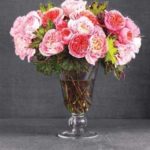Should the fruit dish be placed on the right or left of the altar?
According to traditional folklore, the incense bowl is usually placed in the center of the altar, representing the center where energy accumulates and spiritual essence gathers. On both sides of the incense bowl, there are often oil lamps or candles. The fruit tray is usually arranged in front, while the incense bowl is placed behind, in the direction that the worshipers look towards.
In religious ceremonies, our ancestors applied the principle of “East serene, West fruitful” to decorate the fruit dish and flower vase on the altar. This principle is derived from the laws of nature, with the sun rising in the East and setting in the West, as well as plants flowering before bearing fruit. Therefore, in the ceremony, the flower vase is usually placed towards the East, while the fruit tray is towards the West.

The determination of directions on the altar is done as follows:
Looking out from inside the altar, which is on the left side of the ancestors (to the left), is considered the East side.
The opposite direction (to the right) will be the West side.
This way of thinking originates from traditional habits, when ancestral altars were usually placed in the middle of the house with the main direction being South. Therefore, the flower vase is often placed to the left of the altar (the East side), while the fruit dish will be placed to the right (the West side), providing convenience in arrangement.
Types of fruits commonly placed on the altar
On the altar, people often display 5 types of fruits, taken from the principle of the five elements (Kim – Moc – Thuy – Hoa – Tho) symbolizing the five basic elements of the universe according to ancient Eastern beliefs.
A fruit tray usually consists of 5 types of fruits with diverse colors, such as green bananas, yellow pomelos, white pears, orange oranges, red apples, representing 5 important wishes in daily life: Wealth – Elegance – Longevity – Health – Peace.

In Buddhism, the fruit tray symbolizes the “five good roots,” including Faith – Diligence – Mindfulness – Concentration – Wisdom. The fruits displayed on the fruit tray carry specific meanings:
Pomelo, watermelon: Round shape, fresh, symbolizing fullness and luck for the New Year.
Red fruits: Bright red color, symbolizing success and good luck.
Pear: Sweet, symbolizing convenience and smoothness.
Pomegranate: Many seeds, desiring many offspring, spreading joy in the family.
Peach: Represents progress and prosperity.
Apricot blossom: Represents the wish for daughters’ happiness and happy families.
Apple (red apple): Symbol of wealth.
Dragon fruit: Desires the meeting of dragon and cloud.
Quail eggs in peach-shaped trays: Represents the descent of heavenly luck.
Coconut: Embraces the meaning of “abundance” in the Southern dialect, symbolizing fullness.
Lychee: Sounds similar to “xài” (spending) in the Western pronunciation, wishing for a year of abundance and no shortage.
These fruits not only represent the wishes of the host but also contribute to the decoration of the fruit tray during Tet with deeper meanings, going beyond the spiritual aspect of ancient customs.







































